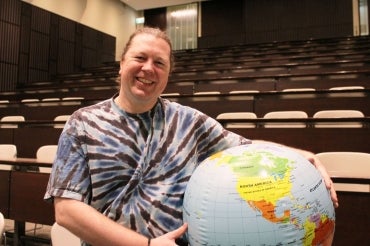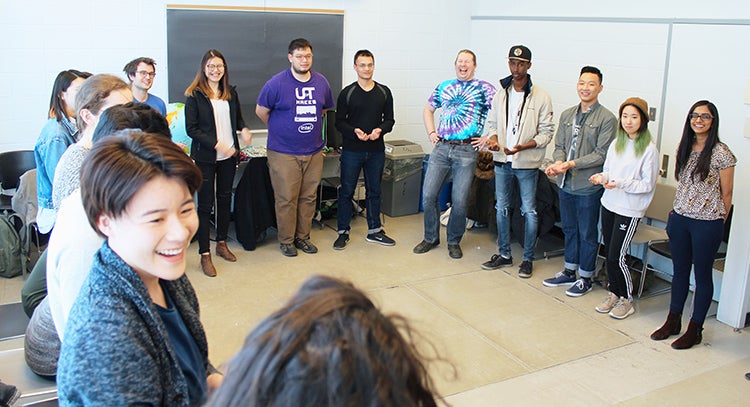How do we solve the global problem of climate change? With technology, says U of T expert

Published: April 18, 2018
Steve Easterbrook, a professor of computer science at the University of Toronto, has been collaborating with climate scientists for more than 10 years.
He was studying how large software engineering teams work, when he says it was suggested to him that he look at climate models as examples of large and complex pieces of software.
“I spent a year visiting a number of big climate modelling labs around the world, studying what they do, what kind of software tools they use, and how they build them,” he says. “As a result, I realized that people with a computer science background can do interesting, useful projects in collaboration with climate scientists.”
Yet, a decade later, Easterbook says climate change remains one of the greatest challenges faced by humanity.
“Thirty years ago, we knew enough about climate change to know exactly what the nature of the problem was, and exactly what society ought to do about it,” he says. “In nearly every aspect of our lives we're using fossil fuel energy and so that means we've got to reinvent everything.”
Next month, the Information and Communications Technology for Sustainability (ICT4S) conference will be held at U of T – the first time outside of Europe. Here, researchers, developers and subject experts will look to identify and address sustainability problems and how digital technology can help, using the city of Toronto as a case study for sustainability.
U of T’s Nina Haikara met with Easterbook to discuss his research, systems thinking, social media and environmentalism.
Tell me about your research area of climate informatics.
I’m looking at the intersection between computer science and climate science. Planetary science uses a lot of big computational tools and there aren't many people who cross over between the two fields. Not just the computational modelling itself, but also how the science is communicated to other audiences. How do we build decision and policy support tools that make use of the science for long-term planning? Climate scientists deal with huge amounts of data, so new and interesting ways of visualizing that, and then new analytics tools.
What are the computational tools being used in climate science?
The big tools in climate science are essentially physics simulation models of how the atmosphere, oceans, ice sheets and everything else interact. These models are good at "what if" questions. What if we doubled carbon dioxide in the atmosphere? What if we increase other kinds of greenhouse gases? What if a whole bunch of volcanoes go off all at once? The model gives you some sense of how the system will respond.
Equally, there are huge datasets now from satellites. What we're missing are tools to process and understand patterns in that data. So if you can match up one of these simulation models with a dataset, you can understand what's going on with the data. But we don't always, for all the data, have a model available that matches it.
What are some of the problems your lab is working on?
A graduate student is working on a project on "nowcasting" – very short-term weather forecasts. You've got a satellite image of current cloud cover and you want to predict what's going to happen next. Instead of going to a big physics simulation model, we give it to image recognition neural networks – which are good at doing video prediction. That's kind of what this problem is – predict the next few frames based on what’s already happened.
Another graduate student is doing downscaling. The physics models use a computational grid that covers the surface of the Earth, but the space between grid points might be tens of kilometres. The idea is to use machine learning techniques to fill the gaps. For example, a city planner wants to know what's going to happen with flooding or a sea-level rise. We train a neural network to interpolate between the grid points what actually happens in places of interest.

Professor Steve Easterbook facilitates a systems-thinking workshop for the Sustainability Office at U of T (photo by Ryan Perez)
You’ve taught courses and workshops on systems thinking and you use puzzles and storytelling to do this. How so?
Systems thinking is this idea that we need to think in terms of whole systems.
Cities are a good example. There’s a transport system. A waste water system. There's a system for moving goods in and out. All of those systems interact. And what happens is they affect each other. Increasingly they're so tightly interconnected that failure in one system cascades into others. If you don't look at it as a whole system, you don't understand what's really going on.
When I was planning my graduate course, someone pointed me to a book of games that helps students understand how to think about these systems. They're very physical games – students tossing balls to each other, jumping over ropes. Each game has typically two or three fairly simple rules and a goal they're trying to achieve. But they also bring to that game a whole load of assumptions they have about the way the world works.
One of the games we play is a fishing game. I tell them we're going fishing for 10 seasons. I've never had a group of students get beyond season three without killing all the fish. We spend a long time discussing what happened and why. It brings out interesting ideas about human behaviour, how rules work and how sometimes it's the rules of the system or your assumptions rather than your individual choices that cause a particular outcome.
You also teach a School of the Environment course on social media and environmentalism?
This course asks the question: How does social media in particular shape our understanding of big environmental problems?
We look at things like how social media has replaced traditional news sources for our understanding of what's going on in the world. And that allows us to get into the issues like fake news, how activist groups make use of social media, and digital surveillance.



